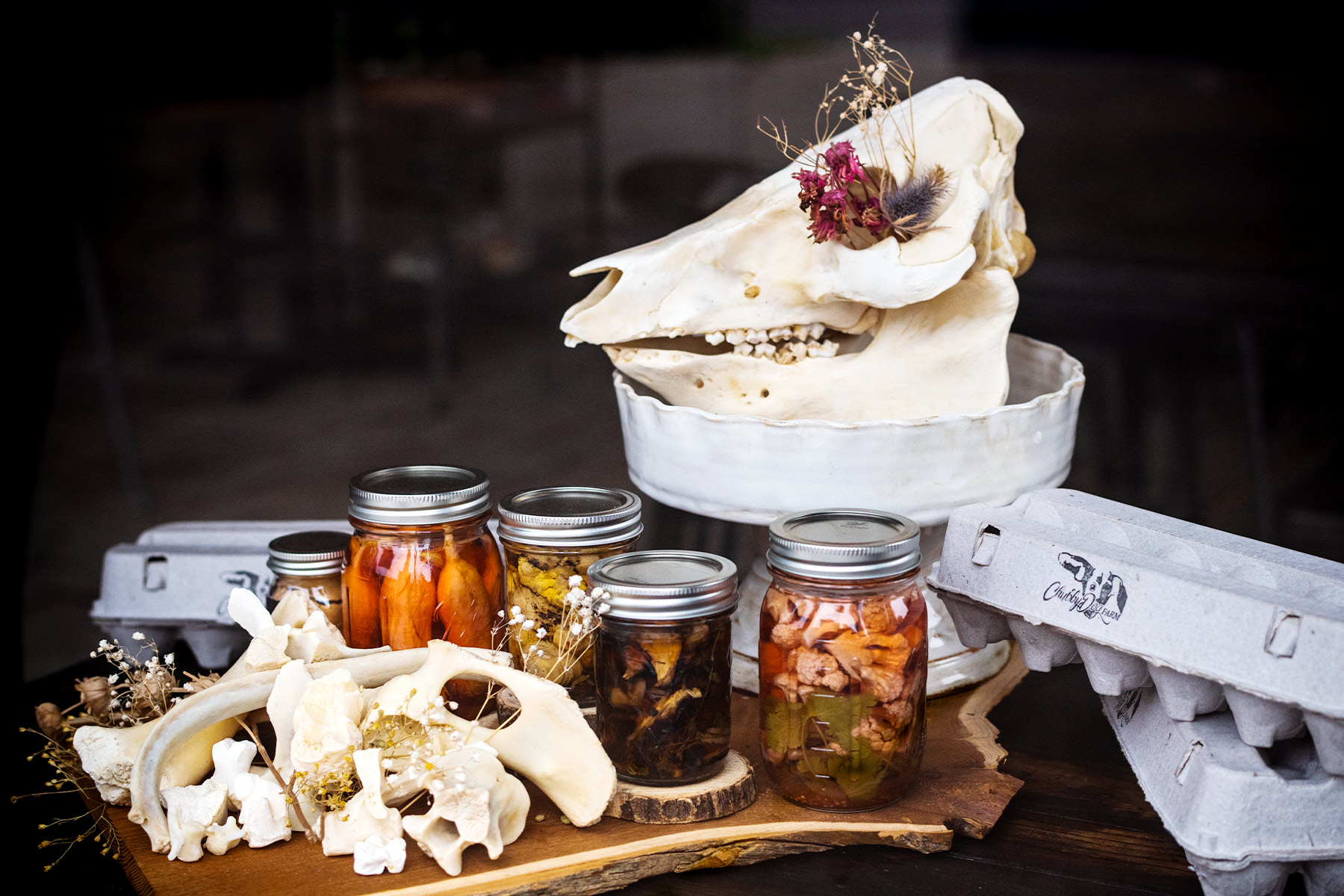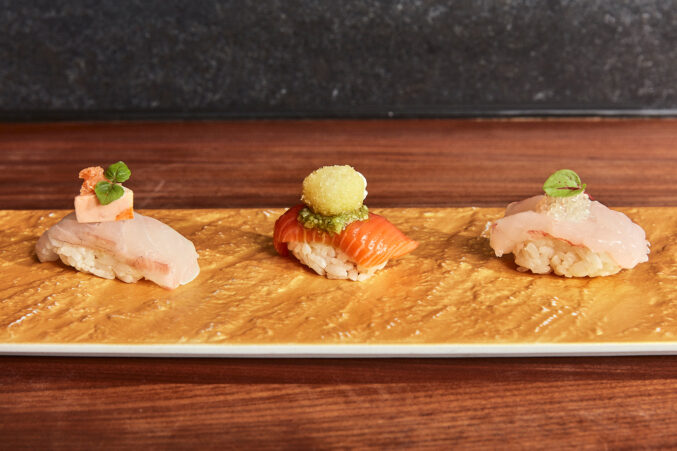Misti Norris wasn’t sure of much when Petra and the Beast opened its doors in a 1932-built gas station in March 2018: she didn’t know how long the lease would be, how many people would show up, whether East Dallas was the right neighborhood for her cooking. But she knew her vision for the food, and that vision has never wavered.
It is being rewarded, now, with a move to bigger, more modern new digs, a new version of Petra that will have room for more of everything—plus, for the first time, drinks. We’ve talked about what to expect in a previous column. Now, I want to look back at the original location of Petra and the Beast and reminisce. The initial lease was a six-month trial run, but over the course of five-plus years, Petra’s old, red gas station became a nationally renowned dining destination on a shoestring budget.
Walking into the original Petra, you were already on notice that this was an unusual restaurant. There was the building itself, a 90-year-old filling station painted a strange, forbidding maroon, almost like tomato glaze on a rack of ribs. There was the signage—just kidding; there wasn’t signage. The parking situation was an ad hoc, “figure it out yourself” gravel lot. It didn’t look like a restaurant. It certainly didn’t look like a good restaurant.
I wonder if the exterior’s strangeness was a way of making sure that the only people who dined at Petra were the people who were ready for it. (I did once witness a couple try to walk into the Saturday night tasting menu, tragically unaware that they needed to make a reservation.) Inside the restaurant, the oddity continued, but it also inverted: instead of testing your determination, it welcomed you closer. The walls were decorated with Norris’ own cute paintings (she’s told me they’re therapeutic), and if you were at first alarmed by the animal skull collection, you’d then notice that they were stuffed with flowers, feathers, and other softening signs of life. (All these decorations are coming back at New Petra.)
In our initial phone chat, Norris told me that the menu would revolve around “everyone’s two favorite things: charcuterie and noodles.” Spoken with natural conviction, not the least doubt that those are everyone’s favorite things and they make perfect sense together. I was so blinded by confidence that I didn’t even try to question her. Eventually, though, Petra and the Beast proved her right.
Of course, it helps that the restaurant has, and always had, Dallas’ best charcuterie. In a restaurant scene where many “charcuterie boards” are made by opening plastic packages of meat and store-bought condiments, Petra was making, hanging, pickling, preserving, and baking everything: the chicken liver mousses, the bresaola, the long seedy crackers, and the mustard. It relates to the average charcuterie board the way a Jimmy’s Food Store sandwich relates to Jimmy John’s.
To the un-Petraed mind, a diet of charcuterie and noodles sounds dangerously short on vegetables. But vegetables were and remain the restaurant’s secret strength. That’s true even if you didn’t order a plate that described its anointed vegetable as “textures,” meaning the veggie appeared multiple times, multiple ways: as a sauce, as a crunchy chip, or as a pickle, just to put an exclamation mark on its essence. On my last visit to the original Petra location, my friends and I had a little betting pool on which veggie would be “textures.” It was tomatoes: a dish of confit Cherokee purple tomatoes, green tomato ribbons, and tomato jus, topped with smoked chicken hearts and breadcrumbs.
With luck, we’ll be enjoying all those hallmarks of the Petra experience again in a few weeks, in a space that gives them more room to grow. Now I’m going to tunnel into my memories of old Petra, just for fun. Memories that date back to the days when it served its à la carte snacks and noodles all day long, when the staff was so small that Norris took my order at the counter, then ran off to cook it. For several years, her only help was Tony Ibarra, now executive chef of La Mina and Anise at The Village.
Those days cultivated the feeling that Petra was an experiment, a food lab, a rebellious underdog. It managed to grow without losing that spirit, and more than any specific dish or decoration, I hope that outside-the-system ethos survives at the new place.

I remember popping in mid-afternoon after my girlfriend finished the Dallas Marathon (the perfect time for a huge serving of pasta) and watching the last tired stragglers run-walk down Haskell Avenue, just outside the restaurant’s windows. I remember BYOB wine dinners with friends, all of us trying to impress each other with our bottles, souvenirs from trips to France or Fredericksburg. I remember the divisive (but, to me, delicious) dessert of mushroom cake with mushroom caramel sauce.
I remember the times Norris tried her hand at Turkish manti, little pyramid-shaped meat dumplings that sing beautifully if you drizzle a red pepper-filled butter sauce over them. Petra’s featured charred leeks as a star ingredient, and they were bigger than Turks would allow—in tradition, manti are supposed to be folded down to the size of your pinky fingernail, still with filling inside—but they were glorious anyway. I remember the New Year’s brunch box Petra produced in the pandemic, and its riff on a Hot Pocket, with real puff pastry and a filling boasting big cubes of local ham.
But the meal I’ll always remember most vividly of all was a night with a unique atmosphere: one of mixed gratitude and fear. We customers looked at each other with skepticism and mild alarm. We scooted our chairs farther away from each other. But we also felt a sort of adrenaline rush of affection for the company of others.

That night was Saturday, March 14, 2020. We didn’t know it when we paid our bill, but the service industry would shut down 48 hours later. We weren’t sure what was happening—how many people had this virus? Was it airborne like the cold? Lingering over chocolate tart and red wine, our dinner felt like the last point of certainty we had left. These were familiar people, a comforting old dining room: surely they would be fine. Surely they would always be here.
Everything is different now. But I hope that, when it reopens next month, Petra and the Beast will still have the same underdog, try-anything spirit. This restaurant built its name by being both rebellious and modest, both challenging and welcoming. Let’s hope that as it grows, its personality doesn’t change.
Author








